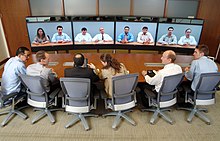Videotelephony refers to the tecnologia[1] that enables video and voice communication between two or more people in real-time. Originating in the late 1870s, it started with simple analog videophone communication on closed-circuit TV systems and evolved over the years with digital advancements such as video compression. Today, it’s widely used for various applications like distance education, telemedicine, and corporate meetings. It offers high-quality audio at lower costs and can function over the Internet[2], making it accessible on various devices including smartphones. However, it’s not without challenges such as maintaining eye contact, managing appearance, and ensuring security[3] against unauthorized access. Its adoption surged due to the COVID-19 pandemic, proving its effectiveness as a cost-friendly alternative to in-person meetings.
Videotelefonia (also known as videoconferencing, video teleconferencing, or simply video call) is the two-way or multipoint reception and transmission of áudio e vídeo signals by people in different locations for real-time communication. A videophone is a telephone with a video camera e video display, capable of simultaneous video and audio communication. Videoconferencing implies the use of this technology for a group or organizational meeting rather than for individuals, in a videoconference. Telepresence may refer either to a high-quality videotelephony system (where the goal is to create the illusion that remote participants are in the same room) or to meetup technology, which can go beyond video into robotics (such as moving around the room or physically manipulating objects). Videoconferencing has also been called visual collaboration and is a type of groupware.

While development of video-conferring started in the late 19th century, the technology only became available to the public starting in the 1930s. These early demonstrations were installed at booths in post offices and shown at various world expositions. It took until 1970 for AT&T to launch the first true video-conferring system, where anyone could subscribe to the service and have the technology in their home or office. Videotelephony also included image phones which would exchange still images between units every few seconds over conventional plain old telephone service (POTS) lines, essentially the same as slow-scan TV. The development of advanced video codecs, more powerful CPUs, and high-bandwidth Internet service in the late 1990s allowed videophones to provide high-quality low-cost color service between users almost any place in the world where the Internet is available.
Useful applications include sign language transmission for deaf e speech-impaired people, distance education, telemedicine, and overcoming mobility issues. It is also used in commercial and corporate settings to facilitate meetings and conferences. Meios de comunicação social organizations have begun to use desktop technologies like Skype to provide higher-quality audio than the cellular phone network, and video links at much lower cost than sending professional equipment or using a professional studio.[citation needed] More popular videotelephony technologies use the Internet rather than the traditional landline phone network, even though modern phone networks use digital packet protocols. Videotelephony software commonly runs on smartphones over digital radiotelephony networks.